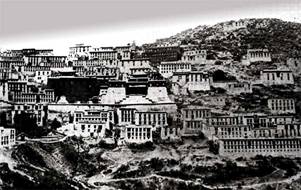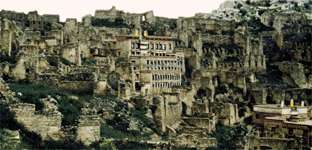|
Dhonden Foundation |
Ganden Monastery in Tibet
first reconstructed buildings in the centerWithin the Gelugpa tradition of Tibetan Buddhism were traditionally five main monasteries, of which the three largest were known as the 'Three Seats'. Before the Chinese occupation, these three monasteries were occupied by thousands of monks and functioned as large monastic universities. The Ganden monastery was the first of these large monasteries, built in 1409 by Lama Tsongkhapa, founder of the Gelug tradition. The Ganden Tripa (litt. "throne-holder of Ganden) is the traditional head of the Gelug school.
Ganden in Tibet is located at some distance to the capital Lhasa, in a protective mountain valley. Early 20th century, it was a flourishing monastic university, housing about 6,000 monks.After 1959, the Chinese occupiers completely destroyed the monastery. Since the 1980s, a small part is being re-built and in use.
The conditions for the monasteries in Tibet have possibly slightly improved over the last few years, but much of the appearance is misleading as the Chinese are more interested in attracting foreign tourists to the Tibetan monasteries than in religious freedom. The Chinese often consider the monks to be a kind of tourist guides rather than people who try to seriously practice their religion. Because of this, Tibetans are still escaping to India in the hope to join a monastic community.
See also the page on Ganden Monastery in India.
|
Office Dhonden
Foundation: p/a Bilderdijkstraat 33, 4819 GA Breda, The Netherlands |
|
KvK
Veluwe & Twente: 08096806 Copyright 2005-2015 © Stichting Dhonden |


